Related Research Articles
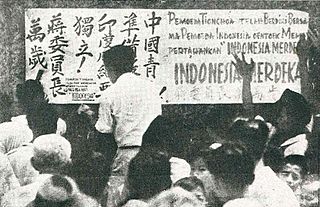
Chinese Indonesians or Orang Tionghoa Indonesia & colloquially Chindos, are Indonesians whose ancestors arrived from China at some stage in the last eight centuries. Most Chinese Indonesians are descended from Southern Chinese immigrants.
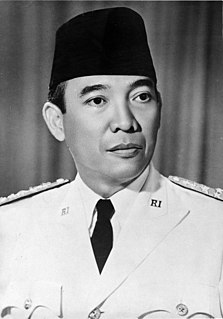
Sukarno was an Indonesian politician who was the first president of Indonesia, serving from 1945 to 1967.

Central Java is a province of Indonesia, located in the middle of the island of Java. Its administrative capital is Semarang. It is bordered by West Java in the west, the Indian Ocean and the Special Region of Yogyakarta in the south, East Java in the east, and the Java Sea in the north. It has a total area of 32,548 km², with a population of 34,552,500 in mid 2019, making it the third-most populous province in both Java and Indonesia after West Java and East Java. The province also includes the island of Nusakambangan in the south, and the Karimun Jawa Islands in the Java Sea. Central Java is also a cultural concept that includes the Special Region and city of Yogyakarta. However, administratively the city and its surrounding regencies have formed a separate special region since the country's independence, and is administrated separately. Although known as the "heart" of Javanese culture, there are several other non-Javanese ethnic groups, such as the Sundanese on the border with West Java. Chinese Indonesians, Arab Indonesians, and Indian Indonesians are also scattered throughout the province.
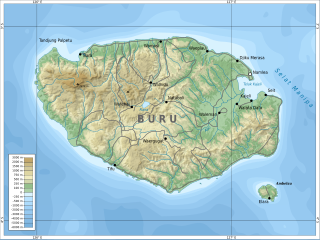
Buru is the third largest island within Maluku Islands of Indonesia. It lies between the Banda Sea to the south and Seram Sea to the north, west of Ambon and Seram islands. The island belongs to Maluku province and includes the Buru and South Buru regencies. Their administrative centers, Namlea and Namrole, respectively, have ports and the largest towns of the island. There is a military airport at Namlea which supports civilian cargo transportation.

Pramoedya Ananta Toer was an Indonesian author of novels, short stories, essays, polemics and histories of his homeland and its people. His works span the colonial period under Dutch rule, Indonesia's struggle for independence, its occupation by Japan during the Second World War, as well as the post-colonial authoritarian regimes of Sukarno and Suharto, and are infused with personal and national history.

Hamengkubuwono IX or HB IX was an Indonesian politician and royalty who was the second vice president of Indonesia, the ninth sultan of Yogyakarta, and the first governor of the Special Region of Yogyakarta.
Budi Utomo, meaning "Prime Philosophy", was the first native political society in the Dutch East Indies. The political society is considered instrumental on the beginning of the Indonesian National Awakening.
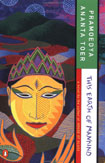
This Earth of Mankind is the first book in Pramoedya Ananta Toer's epic quartet called Buru Quartet, first published by Hasta Mitra in 1980. The story is set at the end of the Dutch colonial rule and was written while Pramoedya was imprisoned on the political island prison of Buru in eastern Indonesia. The story was first narrated verbally to Pramoedya's fellow prisoners in 1973 because he did not get permission to write. The story spread through all the inmates until 1975 when Pramoedya was finally granted permission to write the detailed story.
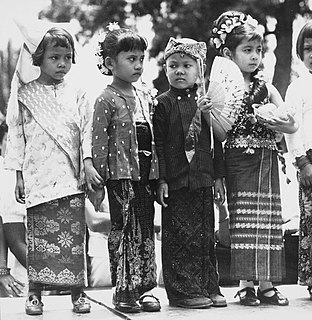
Native Indonesians, also known as Pribumi, are Indonesians whose ancestral roots lie mainly in the archipelago, distinguished from Indonesians of known (partial) foreign descent, like Chinese Indonesians (Tionghoa), Arab Indonesians, and Indo-Europeans (Eurasians).

There are 1,340 recognised ethnic groups in Indonesia. The vast majority of those belong to the Austronesian peoples.
The Buru Quartet or Buru Tetralogy is a literary tetralogy written by Indonesian author Pramoedya Ananta Toer at Buru Island detention camp in Maluku. It is composed of the novels This Earth of Mankind, Child of All Nations, Footsteps, and House of Glass, published between 1980 and 1988. The book series is loosely based on the life of Tirto Adhi Soerjo.
Josephus Beek SJ was a Dutch and later Indonesian Jesuit, priest, educator and politician. From approximately 1965 until approximately 1975 he was a very important political consultant to the Indonesian president Suharto, but always remained in the shade.

Child of All Nations is the second book in Pramoedya Ananta Toer's epic quartet called Buru Quartet, first published by Hasta Mitra in 1980. Child of All Nations continues the story of the lives of the main character, Minke, and his mother in law, Nyai Ontosoroh. By describing the lives of these two people who live in the Dutch controlled islands of Java, Pramoedya is able to discuss many aspects of life in a colonized nation. Child of All Nations explores the social hierarchy in a colonized nation by giving glimpses of how the oppressed colonized peoples, such as the Javanese farmers, are required to be submissive to their occupiers, the Dutch. That wealthy, educated Javanese like Minke and Nyai were still considered inferior to the Dutch due to their Native birth status and frequently simply the color of their skin. The main theme of the novel is, as the title suggests, that the world is becoming more integrated as revealed in the life of the main character Minke, the self-proclaimed "child of all nations" 1. Minke speaks French, Dutch, Malay, and both high and low Javanese. He writes for a newspaper published in Dutch and has to come to terms with being a 'native' in a European controlled world. His worldview is jaded by the fact that he is wealthy and educated, and therefore closer to the Dutch than other Javanese; however, Minke comes to realize the ethical implications of the injustices being done to his people. His life is caught between two worlds, which the novel follows as he tries to understand who he really is, his role in the Dutch-occupied society, and his duty to his people.
Discrimination against people of Chinese descent in Indonesia has been carried out by governments in Indonesia since the time of the Dutch East India Company. Serious violence against Chinese people has occurred at irregular intervals since 1740, when the soldiers of the Dutch East India Company and other ethnic groups from Batavia killed up to 10,000 people of Chinese descent during the Chinezenmoord. The worst outbreaks took place in 1946-49 during the Indonesian National Revolution against Dutch rule. There were significant outbreaks in the early 1960s. Violence against Chinese also took place in 1965 after the failed coup attempt during anti-communist purges, the main target of the killings were Native Indonesian communists. In 1998, many Chinese businesses were burned down and Chinese women were raped brutally.

Tirto Adhi Soerjo was an Indonesian journalist known for his sharp criticism of the Dutch colonial government. Born to a noble Javanese family in Blora, Central Java, Tirto first studied to become a doctor but later focused on journalism. A freelancer since 1894, in 1902 he was made an editor of the Batavia based Pembrita Betawi. Tirto established his first newspaper in 1903 and, four years later, created Medan Prijaji as a medium for educated native Indonesians. This proved his longest-lived publication, lasting over five years before Tirto was exiled in 1912 to Bacan for his staunch anti-colonial criticism.
Si Tjonat is a likely lost 1929 bandit film from the Dutch East Indies directed by Nelson Wong and produced by Wong and Jo Eng Sek. Based on the novel by F.D.J. Pangemanann, the silent film followed an indigenous man who, having killed his fellow villager, flees to Batavia and becomes a bandit. After kidnapping an ethnic Chinese woman, he is defeated and brought to justice.
Frederick D. J. Pangemanann was an Indonesian journalist and novelist.

Footsteps is the third novel in the Buru Quartet tetralogy by the Indonesian author Pramoedya Ananta Toer. The tetralogy fictionalizes the life of Tirto Adhi Soerjo, an Indonesian nobleman and pioneering journalist. This installment covers the life of Minke – the first-person narrator and protagonist, based on Tirto Adhi Soerjo – after his move from Surabaya to Batavia, the capital of Dutch East Indies. The original Indonesian edition was published in 1985 and an English translation by Max Lane was published in 1990.
The Dutch-Indonesian foundation Stichting Opbouw-Pembangoenan was established on 24 March 1947 by the Dutch weekly Vrij Nederland. The foundation had a mixed Dutch-Indonesian board and ran bookstores and a publishing house.
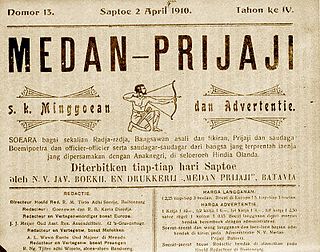
Medan Prijaji was a Malay-language newspaper in the Dutch East Indies founded and operated in Bandung by Tirto Adhi Soerjo between 1907 and 1912. Although it was short-lived, it was considered the first newspaper of the Indonesian National Awakening and inspired the creation of a number of other anti-colonial Malay newspapers. Tirto Adhi Soerjo's life was the basis for the Buru Quartet series of historical novels by Pramoedya Ananta Toer.
References
- 1 2 3 Foreword by Maxwell Ronald Lane [ full citation needed ]
- 1 2 3 Foreword to the English translation by K.S. Jomo[ full citation needed ]
- ↑ Pramoedya Ananta Toer, ‘17 August 1945’, Inside Indonesia, Oct-Dec 2003)
- ↑ Purdey 2006, p. 11.
- ↑ Purdey 2006, p. 13.
- ↑ Foreword to the English translation, Leo Ou-Fan Lee, 4 May 2006[ full citation needed ]
Works cited
- Purdey, Jemma (2006). Anti-Chinese Violence in Indonesia, 1996–1999. Honolulu: University of Hawai'i Press. ISBN 978-0-8248-3057-1.